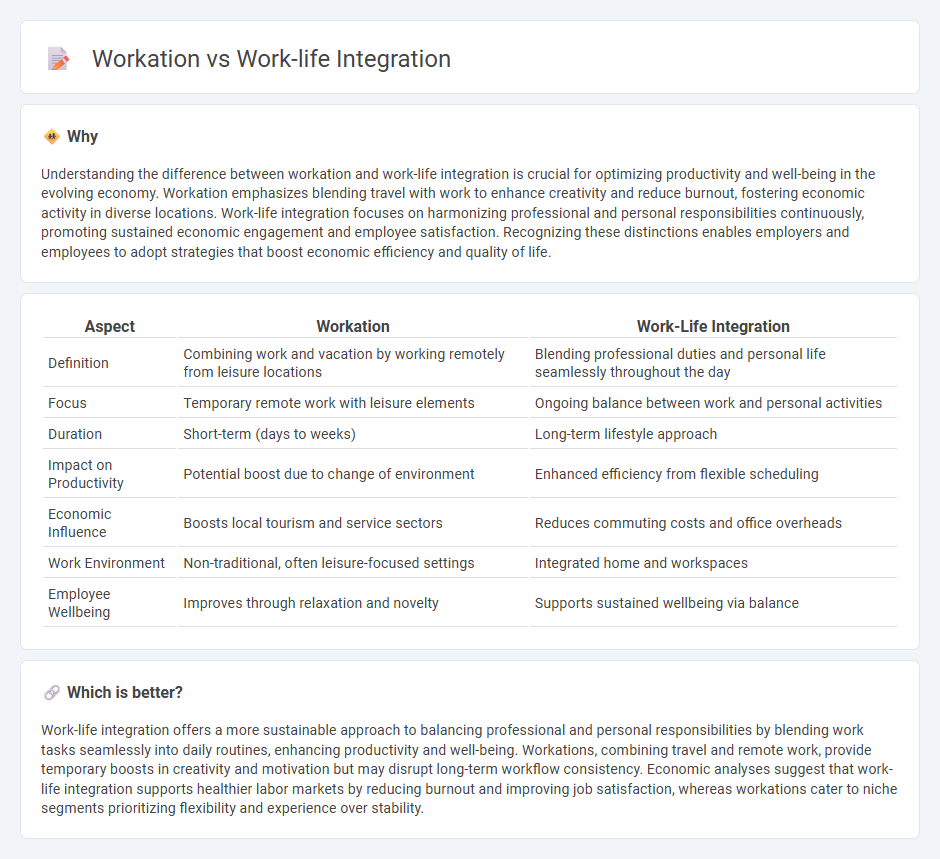
Workation combines remote work with travel, allowing employees to maintain productivity while exploring new destinations, which can enhance creativity and reduce burnout. Work-life integration focuses on blending professional and personal responsibilities seamlessly within daily routines to improve overall well-being and job satisfaction. Discover more about how these evolving work models impact modern economic trends and workforce dynamics.
Why it is important
Understanding the difference between workation and work-life integration is crucial for optimizing productivity and well-being in the evolving economy. Workation emphasizes blending travel with work to enhance creativity and reduce burnout, fostering economic activity in diverse locations. Work-life integration focuses on harmonizing professional and personal responsibilities continuously, promoting sustained economic engagement and employee satisfaction. Recognizing these distinctions enables employers and employees to adopt strategies that boost economic efficiency and quality of life.
Comparison Table
| Aspect | Workation | Work-Life Integration |
|---|---|---|
| Definition | Combining work and vacation by working remotely from leisure locations | Blending professional duties and personal life seamlessly throughout the day |
| Focus | Temporary remote work with leisure elements | Ongoing balance between work and personal activities |
| Duration | Short-term (days to weeks) | Long-term lifestyle approach |
| Impact on Productivity | Potential boost due to change of environment | Enhanced efficiency from flexible scheduling |
| Economic Influence | Boosts local tourism and service sectors | Reduces commuting costs and office overheads |
| Work Environment | Non-traditional, often leisure-focused settings | Integrated home and workspaces |
| Employee Wellbeing | Improves through relaxation and novelty | Supports sustained wellbeing via balance |
Which is better?
Work-life integration offers a more sustainable approach to balancing professional and personal responsibilities by blending work tasks seamlessly into daily routines, enhancing productivity and well-being. Workations, combining travel and remote work, provide temporary boosts in creativity and motivation but may disrupt long-term workflow consistency. Economic analyses suggest that work-life integration supports healthier labor markets by reducing burnout and improving job satisfaction, whereas workations cater to niche segments prioritizing flexibility and experience over stability.
Connection
Workation and work-life integration both emphasize blending professional tasks with personal life to enhance productivity and well-being. By enabling remote work from diverse locations, workation supports flexible schedules that align with individual lifestyle preferences, fostering better work-life balance. This integration reduces burnout and increases job satisfaction, positively impacting overall economic productivity and employee retention.
Key Terms
Flexibility
Work-life integration emphasizes blending professional responsibilities with personal life seamlessly throughout the day, offering continuous flexibility to manage tasks based on individual rhythms. Workation combines work and vacation by allowing professionals to perform job duties from vacation destinations, promoting flexibility through location independence. Explore how these approaches enhance productivity and personal well-being in evolving work environments.
Productivity
Work-life integration enhances productivity by blending professional tasks with personal activities, enabling flexible schedules and reducing burnout. Workation, which combines remote work with leisure in a vacation-like setting, can boost creativity but may challenge focus due to potential distractions. Explore strategies to balance these approaches for optimal productivity in modern work environments.
Employee Well-being
Work-life integration promotes employee well-being by blending professional tasks with personal life, enabling flexibility and reducing stress through adaptable schedules and remote work options. Workation combines work and vacation, offering employees a chance to recharge in new environments while maintaining productivity, which enhances mental health and job satisfaction. Discover how both approaches redefine modern employee well-being and drive organizational success.
Source and External Links
What Is Work-Life Integration? Benefits & Strategies - Work-life integration is the concept of blending work with personal life through flexible policies like telecommuting and flex schedules; both employers and employees play roles in fostering a culture of trust, autonomy, and clear boundaries to achieve a harmonious, sustainable integration that supports well-being and productivity.
Work-Life Integration: Blending Productivity & Well-Being - Work-life integration blends work and personal life to create harmony, achieved through strategies such as prioritizing tasks, using technology wisely, scheduling personal time intentionally, communicating openly with employers, and tailoring integration plans to individual energy levels and needs.
Work-Life Integration: What It Is And 5 Ways to Develop It - Work-life integration emphasizes harmony and flexibility between personal and professional responsibilities, empowering employees to manage their time with benefits to well-being and productivity but also posing challenges like potential burnout without clear plans and support from workplaces and families.
 dowidth.com
dowidth.com